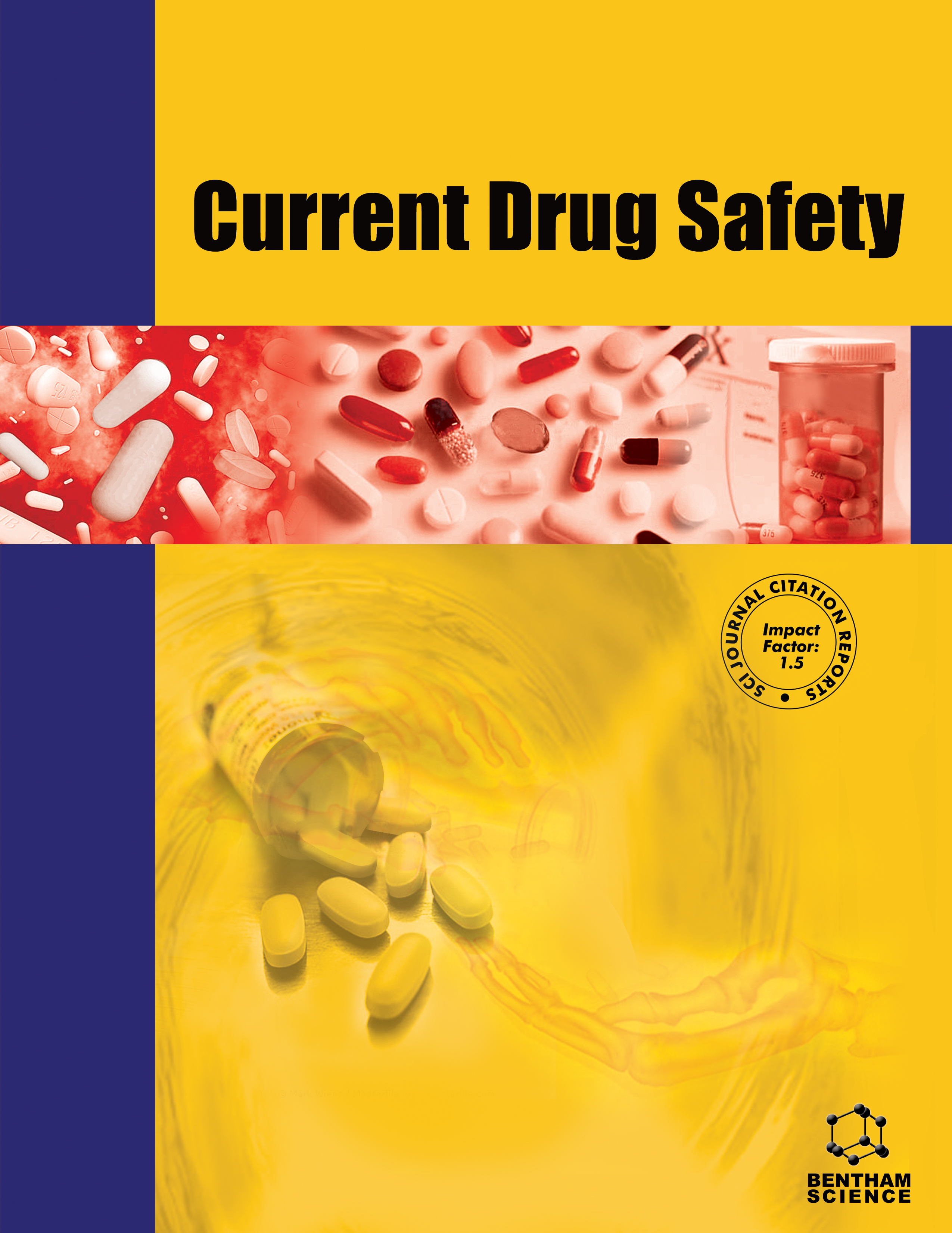- Home
- A-Z Publications
- Current Drug Safety
- Previous Issues
- Volume 2, Issue 3, 2007
Current Drug Safety - Volume 2, Issue 3, 2007
Volume 2, Issue 3, 2007
-
-
Statin-Like Drugs for the Treatment of Brain Cholesterol Loss in Alzheimer's Disease
More LessBy Biondi ElisaAging is one of the most significant risk factors for neurological disorders including Alzheimer's Disease (lateonset AD and sporadic AD), the most common form of dementia. AD is characterized by progressive atrophy and loss of neurons resulting in cognitive deficits, confusion and dementia, culminating in childlike helplessness and death. One of the major pathological hallmarks of the disease are amyloid plaques, composed Read More
-
-
-
Drug Withdrawals in the United States: A Systematic Review of the Evidence and Analysis of Trends
More LessThere have been a number of highly publicized safety-based drug withdrawals in the United States in recent years. We conducted a review of drugs withdrawn since 1993 and examined trends in drug withdrawals. Our objective was to determine the frequency and characteristics of withdrawn drugs and trends since 1993, and to discuss the implications of the findings. We found that a mean of 1.5 drugs per year have been with Read More
-
-
-
The Potential of Selected Prostanoid Receptors as Targets in a New Therapeutic Strategy for Allergy and Immune Diseases
More LessAuthors: Kenji Kabashima and Yoshiki TokuraAllergy and immune diseases including asthma, atopic dermatitis, rhinitis, and autoimmune diseases have been treated mainly with steroid based therapy that has multiple side effects. Even then, these allergic diseases are sometimes still not easy to control. Therefore, new effective treatments with fewer side effects are expected to be developed. Prostanoids consisting of prostaglandins and thromboxane are cycloo Read More
-
-
-
Human-Based In Vitro Experimental Systems for the Evaluation of Human Drug Safety
More LessBy Albert P. LiAccurate prediction of human drug safety remains a major challenge for drug development. Species-difference in drug toxicity represents a main reason for the difficulty in the prediction of human drug toxicity with nonhuman animal models. A combined in vitro-in vivo strategy (IVIVS), using human-based in vitro experimental systems to derive humanspecific information, and animal systems for in vivo variables, may lead to Read More
-
-
-
QT Prolongation and Safety in the Indian Population
More LessAuthors: Jayesh Dabhi and Anita MehtaThe QT interval in electrocardiogram (ECG) reflects the total duration of ventricular myocardial depolarization and repolarization. It has been well recognized that many condition may cause QT interval prolongation. Unfortunately, numbers of cardiac and non-cardiac drug prolong the QT interval and cause a distinctive polymorphic ventricular tachycardia termed torsade de pointes (TdP). TdP can degenerate into ventricul Read More
-
-
-
Oleamide Derivatives are Prototypical Anti-Metastasis Drugs that Act by Inhibiting Connexin 26
More LessAuthors: Hiroshi Nojima, Yusuke Ohba and Yasuyuki KitaDespite considerable research, metastasis remains a major challenge in the clinical management of cancer. Recent reports show that abnormally augmented expression of Cx26 is responsible for the enhanced spontaneous metastasis of mouse BL6 melanoma cells. The function of Cx26 appears to be responsible for this phenotype since exogenous expression of a dominant-negative form of Cx26 and oleamide derivative Read More
-
-
-
Safety of Drug Eluting Stents: Current Concerns and Controversies
More LessAuthors: Shahzad G. Raja and Geoffrey A. BergCoronary artery stenting is currently the most frequently performed percutaneous coronary intervention for the treatment of coronary artery disease. Recently, drug- eluting stents, loaded with anti-inflammatory, anti-migratory, antiproliferative or pro-healing drugs, have revolutionized the management of coronary artery disease by markedly reducing in-stent restenosis. Despite the excellent short- and mid-term results of r Read More
-
-
-
Zolpidem and Traffic Safety - The Importance of Treatment Compliance
More LessAuthors: Joris C. Verster, Edmund R. Volkerts, Berend Olivier, William Johnson and Laura LiddicoatZolpidem is among the most frequently prescribed hypnotic drugs for those who suffer from insomnia. Recent media reports drew attention to driving impairment after zolpidem misuse. This review summarizes the available data on the effects of recommended use and misuse of zolpidem on driving ability and traffic safety. Both experimental studies and roadside evidence were taken into account. From these studies it mus Read More
-
-
-
Drotrecogin Alfa (Activated) in the Treatment of Severe Sepsis
More LessSevere sepsis and septic shock are common in the critically ill patient and account for considerable morbidity and mortality not to mention the high associated costs. Advances in our understanding of sepsis pathophysiology and in the important link between the inflammatory response to sepsis and activation of coagulation led to the development and licensing of the first ever, specific, immunomodulatory anti-sepsis drug. Drotre Read More
-
-
-
Desmopressin 30 Years in Clinical Use: A Safety Review
More LessAuthors: Johan Vande Walle, Mette Stockner, Ann Raes and Jens P. NorgaardDesmopressin acetate is the synthetic analogue of the antidiuretic hormone arginine vasopressin. It has been employed clinically for >30 years in a range of formulations: intranasal solution (since 1972), injectable solution (since 1981), tablets (since 1987), and most recently, an oral lyophilisate (since 2005). The antidiuretic properties of desmopressin have led to its use in polyuric conditions including primary nocturnal enuresis, Read More
-
Volumes & issues
-
Volume 20 (2025)
-
Volume 19 (2024)
-
Volume 18 (2023)
-
Volume 17 (2022)
-
Volume 16 (2021)
-
Volume 15 (2020)
-
Volume 14 (2019)
-
Volume 13 (2018)
-
Volume 12 (2017)
-
Volume 11 (2016)
-
Volume 10 (2015)
-
Volume 9 (2014)
-
Volume 8 (2013)
-
Volume 7 (2012)
-
Volume 6 (2011)
-
Volume 5 (2010)
-
Volume 4 (2009)
-
Volume 3 (2008)
-
Volume 2 (2007)
-
Volume 1 (2006)
Most Read This Month
Article
content/journals/cds
Journal
10
5
false
en


